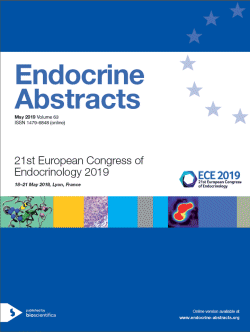Searchable abstracts of presentations at key conferences in endocrinology

21st European Congress of Endocrinology
Lyon,
France
18 May 2019 - 21 May 2019
18-21 May 2019, Lyon, France
Poster Presentations
Diabetes, Obesity and Metabolism 2
ea0063p563 | Diabetes, Obesity and Metabolism 2
Autoimmune diabetes mellitus adult patients having latent autoimmune diabetes of adulthood (LADA) form exhibit different prevalence of accompanying autoimmune diseases than patients with conventional (juvenile) autoimmune type 1 diabetes: Furthermore, anti-GAD autoantibodies are strongly associated with accompanying autoimmune diseases in patients with autoimmune diabetes mellitus
ea0063p571 | Diabetes, Obesity and Metabolism 2



